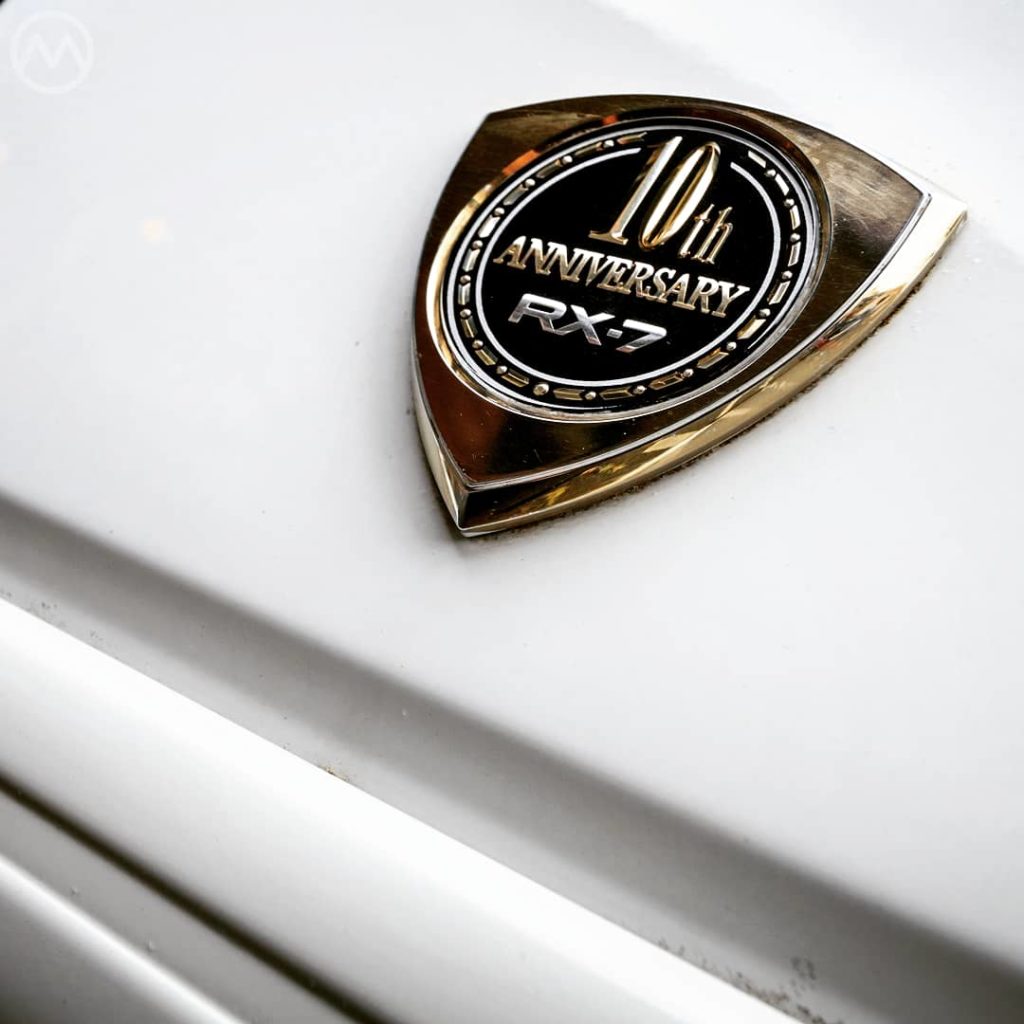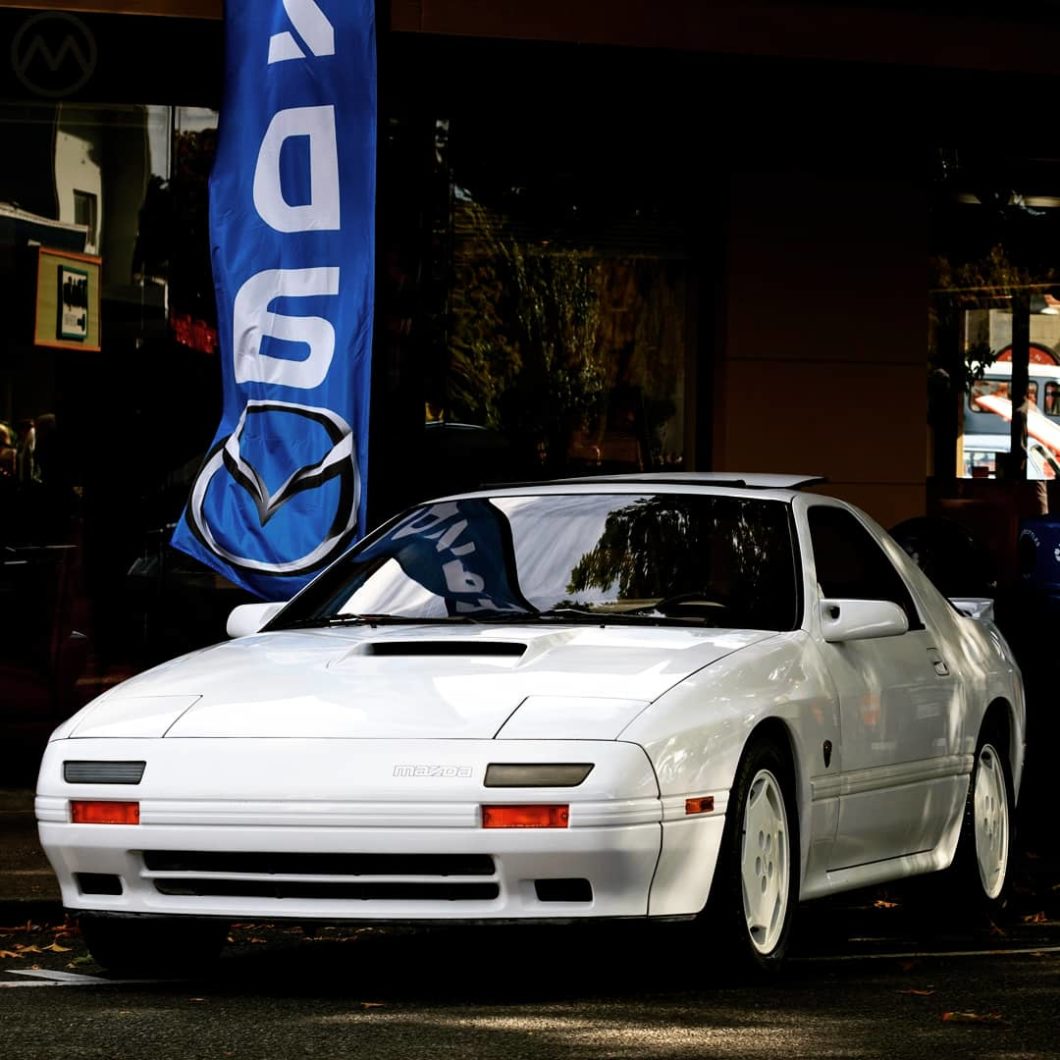Everybody’s celebrating “100 years of Mazda” this week (though it did not build any vehicles until 1931) so here’s an actual anniversary Mazda – 1988’s 10th Anniversary RX-7.
Mazda’s road to recovery from its slump in the mid-1970s owed as much to new piston-engined cars like the GLC (aka Familia/323) as the FB/SA22C Rotary Savanna RX-7, but the sports car was a huge success at a time when Mazda needed a hit – almost half a million were made.
Only three years into that record run, the company began planning for a successor. “Project P747” began in the summer of 1981 – culminating in the “FC” RX-7 introduced in late 1985. Designed under engineer Akio Uchiyama, the project had a strongly American bent from the beginning.
California Connections
Uchiyama and his engineering team spent several months in the Mk1 RX-7’s best market, the USA, at the request of Mazda Engineering chief Kenichi Yamamoto. What do Americans want? Find out. The lead stylist on the project, Yasuji Oda, shortly thereafter took five designers (including Matasaburo Maeda, who worked on the original RX-7; and Takashi Ono, an interior designer) over to Mazda North America’s then brand-new MANA studio in California.
This is the studio where Tom Matano, Mark Jordan, Masao Yagi, and others would eventually create the MX-5; but at that time it was just beginning. It was in California that the team settled on the layout (slightly bigger than the original) and a target car to benchmark against.
The new car would be a little bigger and a little fancier and slightly higher priced thanks to the rising value of the Yen and import quotas. The target car was the Porsche 924, but by the time development really began, the 924 had been withdrawn from the U.S. in favor of the 944. Exchange rates had made the 924 too expensive to sell in America, and the 944 would be a more profitable car anyway. The same thinking was true of the decision to grow the RX-7, thought it would be a bargain compared to the 944.
The FC was often later compared to the Harm Lagaay’s Porsche shape, and indeed consumer clinics put the P747 prototypes up against 944s, but other treatments, including one looking rather like the Mk3 Supra, were considered and the goal was a partial evolution and modernization of the original shape. It was also widely compared with Mitsubishi’s Starion.
The new shell, designed mostly on computers rather than drafting tables, was much more rigid and the shape even more streamlined – the FC had a drag coefficient of just .29. It also added a small pair of rear seats, though adults would not want to spend any time back there.
Like most eighties Japanese cars, the new RX-7 was a high-tech machine – speed-variable power steering (now rack and pinion instead of recirculating ball), variable damping activated by a dash switch (a sport mode) and, of course, an updated fuel-injected, turbocharged Rotary engine, the development of which was led by Hiroshi Ohzeki. Later on, tuners would extract much more from the 13B-DEI than the factory did, a testament to the engine’s abilities.
The car debuted at the 1985 Tokyo show, though in Japan you could order one as early as three weeks before the show. Production began in Ujina a few weeks before, with a target of building 6,000 cars a month – most of which were earmarked for the U.S. market. Some thought was given to calling the car RX-8, but the old name was retained in the theory that it already had resonance.
The FC RX-7 Arrives
A bargain next to the 944, the FC was almost $15K cheaper depending on the models you chose, and it was red hot as far as the dealers were concerned. 86,000 customers lined up for one in 1986 – more than 25% of Mazda’s U.S. sales that year.
The FC offered the injected 13B that premiered on the 1984 RX-7 GSL-SE standard, in N/A and turbo form. In Japan, things were a little different as sales were concentrated on the turbo.
A luxury GXL version had full leather and resembled a hybrid of luxury coupe and sports car – by design. That the car was a better long-haul GT was evident in reviews similar to Road & Track’s: “Unlike it’s rather noisy, hard-riding, and nervous predecessor, the new RX-7 is an ideal car for a fatigue-free cross-country journey.” That’s probably selling the SA22C/FB quite short, but the FC was definitely a step towards a refined GT.
Although it had gained about 250 lbs. and some size, the FC lost little of the excitement of the original, and sales were very robust through 1989. Moving the car upmarket had left a void below, which would ultimately be filled by Mazda’s next sporty project, the previously-mentioned MX-5.
The big news in 1988, just before a mid-cycle refresh and the arrival of the Miata, were the FC Convertible and the 10th Anniversary car. The Convertible required significant engineering updates to make it as rigid and quiet as the Coupe, or at least to approximate the coupe, but that’s a tale for another day. The 10th Anniversary car was meant to celebrate the model’s huge success – well over 650,000 RX-7s of both generations had been built by that time.

Monochrome was all the rage at the time, and the 10AE was all Crystal White, not unlike the 300ZX “Shiro edition” that was also current in 1988. It was mostly an appearance package (wheels, trim, leather, a MOMO shifter, special key, badges, aero bits) but all 10AEs were based on the rapid 187-hp Turbo II.
Mazda built just 1,500 units to commemorate the occasion and they’re one of the rarer Mazda specials today. 11 years later, a similar 10th Anniversary Miata arrived.
The 10AE FC RX-7 came and went fairly quickly, and in 1989 the arrival of the Miata began to eat away at FC sales. It was however, fast and affordable and sold in huge numbers up to that time. In the end, about ~272,000 were made including JDM and global market versions.

